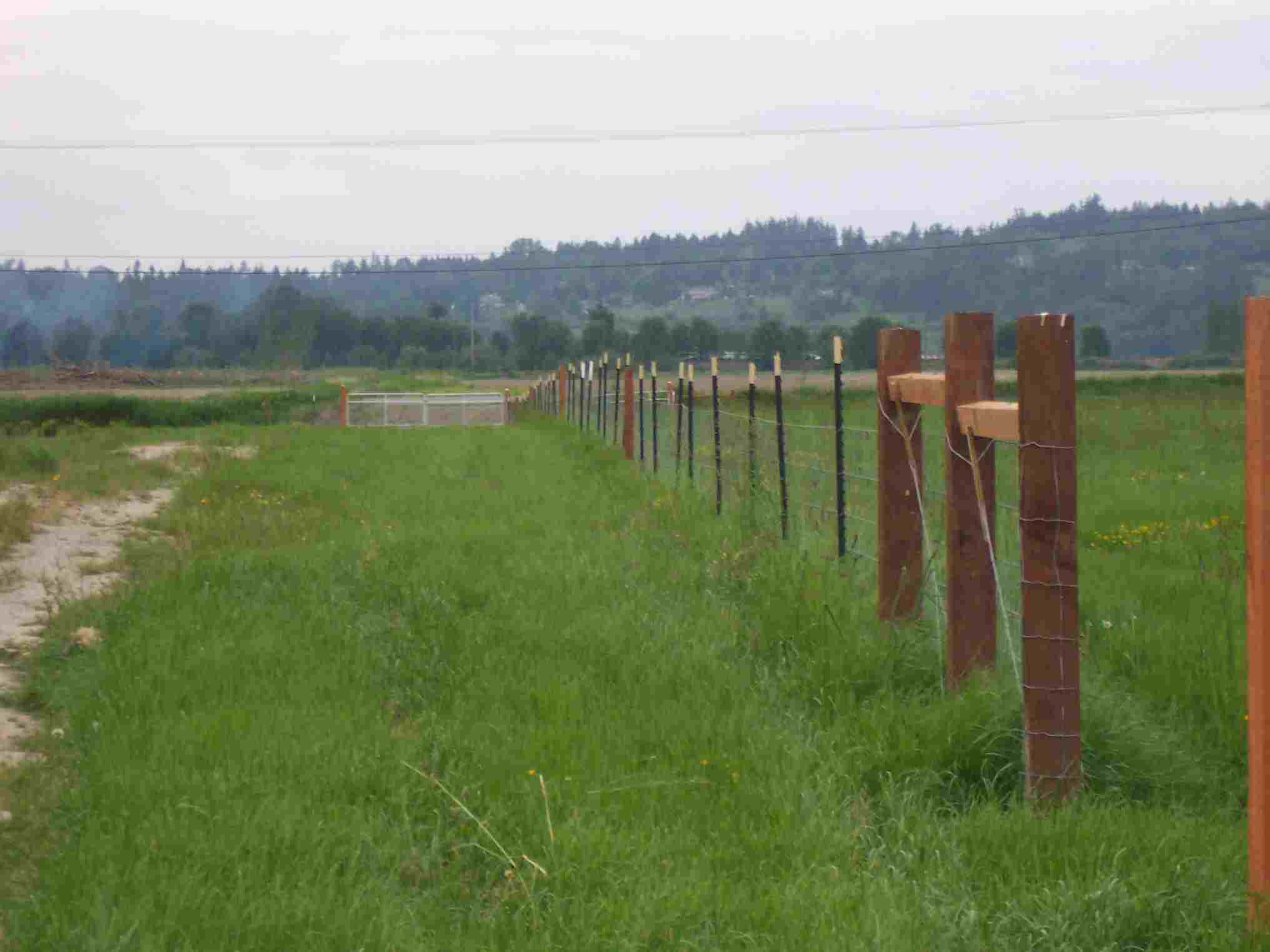 I’m gearing up to start another round of fencing. I do add concrete my fence post holes, because in the floodplain, the flotation forces of full-submersion flooding can cause whole fence lines to float- or so I’m told by a neighbor who learned this the hard way! So the question I’m pondering this year is, pour the concrete in the hole dry and let it cure on its own, or pre-mix the concrete first? Continue reading “Fence Posts: Wet or Dry Cure Concrete?”
I’m gearing up to start another round of fencing. I do add concrete my fence post holes, because in the floodplain, the flotation forces of full-submersion flooding can cause whole fence lines to float- or so I’m told by a neighbor who learned this the hard way! So the question I’m pondering this year is, pour the concrete in the hole dry and let it cure on its own, or pre-mix the concrete first? Continue reading “Fence Posts: Wet or Dry Cure Concrete?”
Category: Farming
Frozen Colostrum For The Future
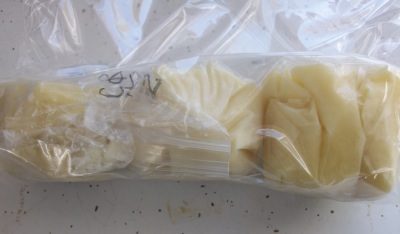 I only had one ewe single this year, but I took full advantage of that and milked colostrum out of her three times in the first twelve hours, to freeze for future use. The rest of the ewes had twins or triplets, so I didn’t want to rob any of them. Continue reading “Frozen Colostrum For The Future”
I only had one ewe single this year, but I took full advantage of that and milked colostrum out of her three times in the first twelve hours, to freeze for future use. The rest of the ewes had twins or triplets, so I didn’t want to rob any of them. Continue reading “Frozen Colostrum For The Future”
Sewn-Up Duck Adopts Babies
 A funny thing has happened with the recently sewn-up duck and the babies with which she’s sharing her A-frame. They’ve decided they’re family. 🙂 Continue reading “Sewn-Up Duck Adopts Babies”
A funny thing has happened with the recently sewn-up duck and the babies with which she’s sharing her A-frame. They’ve decided they’re family. 🙂 Continue reading “Sewn-Up Duck Adopts Babies”
Sewn-Up Duck
Last Sunday I was awoken by the Border Collies barking madly at 2am. I took a look out the window to see the ducks all clustered, standing at attention in their pen. My flashlight caught Ms. Coyote behind their pen as she dashed away. I tromped out in my robe and boots, all looked ok, until I got to the back of the pen. Darn, she got one. Or did she? Continue reading “Sewn-Up Duck”
The Odd Couple: Ears, Eyes, Bark and Bite
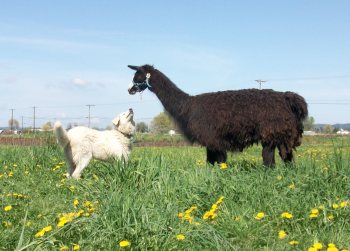 Here is our livestock guardian pair, displaying their somewhat adversarial relationship. Neither one is really afraid of the other, and they haven’t thus far hurt each other and don’t seem to have intent to. But, the dog enjoys getting some sport out of hassling the llama by barking at her, and leaping up to air-snap at her head. This annoys the llama to no end, and she swings her long neck around with flattened ears, trying to communicate her irritation. Sometimes she even spits at the dog, but the dog doesn’t mind and keeps at her lively sport. 🙂 Continue reading “The Odd Couple: Ears, Eyes, Bark and Bite”
Here is our livestock guardian pair, displaying their somewhat adversarial relationship. Neither one is really afraid of the other, and they haven’t thus far hurt each other and don’t seem to have intent to. But, the dog enjoys getting some sport out of hassling the llama by barking at her, and leaping up to air-snap at her head. This annoys the llama to no end, and she swings her long neck around with flattened ears, trying to communicate her irritation. Sometimes she even spits at the dog, but the dog doesn’t mind and keeps at her lively sport. 🙂 Continue reading “The Odd Couple: Ears, Eyes, Bark and Bite”
Living With Coyotes: Part 2
 How to live in balance with your local coyote population? Here’s some of my thinking and learning thus far.
How to live in balance with your local coyote population? Here’s some of my thinking and learning thus far.
Of course the first temptation is to shoot at them, there is a very alluring promise of an immediate sense of “justice” and relief of seeing that thief dead! Removing certain animals from the population is a valid part of predator management. But, only a part. Continue reading “Living With Coyotes: Part 2”
Living With Coyotes: Part 1

We are sure having trouble with the coyotes this year. Last year, we experienced almost zero predation, I think we had one duck go missing all year, and no sheep losses. We rarely saw coyotes during the day, and when we did, they were off in the distance, hunting mice in the fields. At a human encounter, they quickly made themselves scarce. We heard them howling at night, so knew they were present, but we were all coexisting OK.
But, starting in January, that has drastically changed! Continue reading “Living With Coyotes: Part 1”
Shedding Sheep
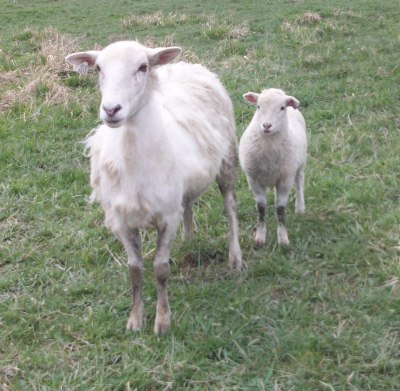 Our Katahdins are all in various states of shedding off their winter hair coats. This is #10 and her ram lamb. You can see her winter coat peeling off her shoulders. Once they are done shedding, they look so clean and trim!
Our Katahdins are all in various states of shedding off their winter hair coats. This is #10 and her ram lamb. You can see her winter coat peeling off her shoulders. Once they are done shedding, they look so clean and trim!
The birds have been appreciating the wool in the field, we often see them carrying it off for nesting material.
A few days ago, when I was out in the field moving fencing, a woman stopped by. She asked if I would move the dog house to be closerto the sheep, so that Bronte would be more likely to use it (she hasn’t gone near it that I know of). The woman and I talked for a while, I told her a bit about the Maremma breed, and about Bronte and her life as a livestock guardian. In the end, she said, “ok, thank you, I feel better now.” I guess it’ll just take a lot of education to convince people that Bronte’s life isn’t so horrible after all!
Garden Beds
 We’ve been working on our new garden beds for the last several months. Kirk built these three raised beds using barn wood- these are floor joists from the second story. Though the boards have some damage, they are so thick, they should still last another 100 years!
We’ve been working on our new garden beds for the last several months. Kirk built these three raised beds using barn wood- these are floor joists from the second story. Though the boards have some damage, they are so thick, they should still last another 100 years!
We considered having topsoil brought in, but ended up using what we have here. Kirk scooped up soil outside of the barn, which was mostly made of old barn waste (manure + whatever else was in there years ago). Later I mixed in sand, which we also have in streaks throughout our property. Lastly, I added most of the layers of straw bedding from the ducks’ A-frame shelter, which had been composting since last fall.
I rototilled all this in. A lot of rocks ended up coming with the barn waste soil, as I think that manure was on top of what was originally a rock driveway; and in some places, we dug a bit too deep when scooping it up. So, we hand-picked as many rocks as we could. It looks pretty good, I think it will perform well.
We’ve planted peas, beans, artichokes, carrots, parsley, cilantro, brussel sprouts , green onions and lettuce. Many things are sprouting already. We plan to add some potatoes too. Kirk has also been making some terrace gardens on the hillside, and those contain tomatoes and strawberries.
We also plan on putting in a corn patch on top of the pen where the sheep stayed during flooding and lambing. We need to rototill that first! We’re keeping an eye on our neighbors, the Stockers, to see when they plant their corn. Ed Stocker, aka the “Corn King,” takes the temperature of the soil before choosing when to plant. He says that if you plant before it’s warm enough, the corn seeds just rot in the ground. They haven’t even plowed their corn field yet, so they must think it’s a ways off before it’ll be warm enough!
Poultry Houses
 I finally finished building my two new yuppie A-frame poultry houses a few weekends ago. I made one for chickens, with nest boxes and doors in the back for collecting eggs. The other one is just a plain night house. The two new houses are on the left, fully roofed; and the older, half-wire house is on the right.
I finally finished building my two new yuppie A-frame poultry houses a few weekends ago. I made one for chickens, with nest boxes and doors in the back for collecting eggs. The other one is just a plain night house. The two new houses are on the left, fully roofed; and the older, half-wire house is on the right.
I have the five duck hatchlings growing in the half-wire house. I bought some day-old Rhode Island Red chicks at the local feed store. I considered mail-ordering some, but have read a lot of the hatcheries are back-ordered quite a bit, and I was convinced I only needed a few. The feed store’s order was arriving right after I finished the houses.
I figured I only wanted about a dozen chickens, max, but asked for fifteen, figuring on some mortality. After I paid, the cashier said, “oh, you qualify for six free chicks based on the amount you spent today.” Ok, so now I have 21 chickens, and naturally, zero mortality! I think once you get them out of that mass-production environment into a roomy, warm pen with very accessible food and water, their individual odds of survivial go way up. Plus, I got there soon after their order had arrived, so got “fresh” chicks, and picked the most vigorous ones. I kept them in the house for the first several days until they were well established.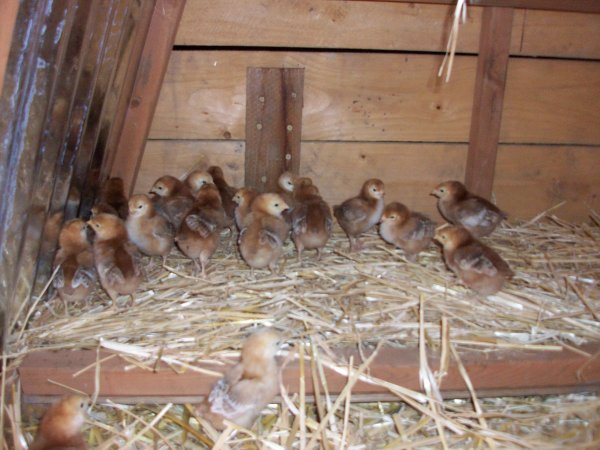
This was a pullet order, but I’m sort of hoping there will be a screw-up and at least one rooster in there, as I’d like fertile eggs. If not, I can buy one later. But these gals are a start, this fall, we should be able to start enjoying fresh chicken eggs, to augment the duck eggs. When they get a little bigger, I’ll teach them to range during the day, but go back into their house at night.